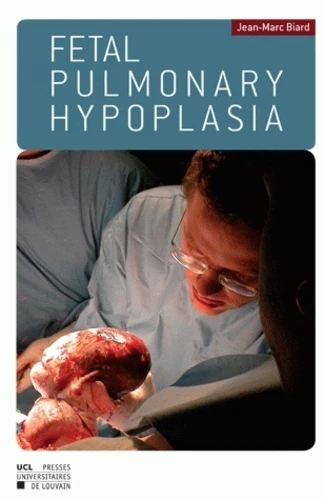Fetal Pulmonary Hypoplasia
Par :Formats :
- Paiement en ligne :
- Livraison à domicile ou en point Mondial Relay indisponible
- Retrait Click and Collect en magasin gratuit
- Réservation en ligne avec paiement en magasin :
- Indisponible pour réserver et payer en magasin
- Nombre de pages186
- PrésentationBroché
- Poids0.306 kg
- Dimensions24,0 cm × 16,0 cm × 1,1 cm
- ISBN978-2-87463-205-1
- EAN9782874632051
- Date de parution01/04/2010
- CollectionHors collection (Presses unive
- ÉditeurPresses Universitaires Louvain
Résumé
The human lung is a complex and highly specialized organ with over 40 differentiated cell types. Optimal lung function is determined prenatally and an in utero adverse event may interfere with the delicate lung development process and lead to variable degrees of pulmonary hypoplasia. Fetal lung underdevelopment is a major concern for obstetricians and pediatricians since pulmonary hypoplasia (PH) may lead to severe respiratory distress immediately after birth and even to neonatal death or potential long-term morbidity.
During a five year period, the author had the opportunity to conduct in experienced teams several studies on different fetal malformations that dealt with multiple aspects in the wide spectrum of PH : gastroschisis (GAS), giant omphalocele (GO), low obstructive uropathies (LUTO) and congenital diaphragmatic hernia (CDH). The thesis, which focuses on four papers published as first author, reviews important features of PH for a fetal medicine specialist.
Three other publications as co-author are presented at the end of the manuscript as "additional contributions".
During a five year period, the author had the opportunity to conduct in experienced teams several studies on different fetal malformations that dealt with multiple aspects in the wide spectrum of PH : gastroschisis (GAS), giant omphalocele (GO), low obstructive uropathies (LUTO) and congenital diaphragmatic hernia (CDH). The thesis, which focuses on four papers published as first author, reviews important features of PH for a fetal medicine specialist.
Three other publications as co-author are presented at the end of the manuscript as "additional contributions".
The human lung is a complex and highly specialized organ with over 40 differentiated cell types. Optimal lung function is determined prenatally and an in utero adverse event may interfere with the delicate lung development process and lead to variable degrees of pulmonary hypoplasia. Fetal lung underdevelopment is a major concern for obstetricians and pediatricians since pulmonary hypoplasia (PH) may lead to severe respiratory distress immediately after birth and even to neonatal death or potential long-term morbidity.
During a five year period, the author had the opportunity to conduct in experienced teams several studies on different fetal malformations that dealt with multiple aspects in the wide spectrum of PH : gastroschisis (GAS), giant omphalocele (GO), low obstructive uropathies (LUTO) and congenital diaphragmatic hernia (CDH). The thesis, which focuses on four papers published as first author, reviews important features of PH for a fetal medicine specialist.
Three other publications as co-author are presented at the end of the manuscript as "additional contributions".
During a five year period, the author had the opportunity to conduct in experienced teams several studies on different fetal malformations that dealt with multiple aspects in the wide spectrum of PH : gastroschisis (GAS), giant omphalocele (GO), low obstructive uropathies (LUTO) and congenital diaphragmatic hernia (CDH). The thesis, which focuses on four papers published as first author, reviews important features of PH for a fetal medicine specialist.
Three other publications as co-author are presented at the end of the manuscript as "additional contributions".

